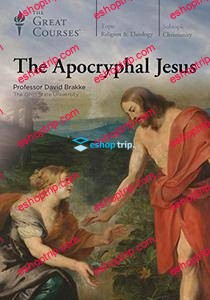Course No. 6371 | .MP4, AVC, 680 kbps, 856×480 | English, AAC, 125 kbps, 2 Ch | 24×30 mins | + PDF Guidebook | 4.27 GB
Lecturer: David Brakke, Ph.D., M.Div.
The New Testament gives us 27 canonical texts—gospels, letters, and more—but these works are only a tiny fraction of the many volumes written about the life of Jesus, his family, and the apostles. This alternative body of literature falls under the category of “apocrypha,” which means “hidden” or “secret,” and it offers fascinating insights into the early Christian world and how different groups understood the teachings of Jesus and the first apostles.
These early Christian apocryphal works, which range from infamous texts such as the Gospel of Thomas to obscure fragments such as the Gospel According to the Egyptians, are more than historical curiosities. The canonical Bible is one of the most influential books in all of Western history, but you might be surprised to find out how many gaps and contradictions the New Testament contains. For instance, if you only read the gospels of Matthew, Mark, Luke, and John, you might wonder:
Why does the Catholic Church venerate the Virgin Mary when she plays such a surprisingly minor role in the canonical gospels?
How did many come to believe that three wise men visited the infant Jesus? And who were they and where did they come from?
Where did the story of Peter’s upside-down crucifixion come from?
Much of what we know about Jesus today actually comes from apocryphal sources rather than the Bible. The Apocryphal Jesus is your chance to learn about the breadth and depth of the early Christian world from a variety of sources—many of which were considered heretical at various times in history. Over the course of 24 revealing lectures, Professor David Brakke of The Ohio State University takes you on a tour of this world and surveys the major apocryphal works that have survived. From forged letters to recently discovered gospels, The Apocryphal Jesus explores the stories and ideas that shaped the foundations of early Christian thought—and continue to influence Christianity today.
Deepen Your Understanding of Figures from the New Testament
In the early centuries of Christianity, there was a concerted effort among church leaders to shape a single narrative, which led to the New Testament canon. Because it has widely been accepted as the official version of Christian doctrine, we tend to think of the New Testament as complete and comprehensive—which you will discover is far from the truth. Early Christian writing contained genres galore, including:
Gospels
Letters
Novels
Apocalypse narratives
And more
Early Christian authors wrote reams of literature about Jesus, his family, and the apostles, drawing from an even larger oral tradition. Because of the sheer volume of this material, these writers often struggled to create a signal through the noise, with some writers resorting to penning forged works under the guise of better known figures, including Paul and even Jesus himself. Other writers declared their works “secret” or “hidden” as a way to drum up interest.
Even though only a tiny portion of apocryphal works survive today—many as mere fragments discovered recently in the 20th and even 21st centuries—reviewing this literature gives us a host of new angles on well-known figures from the Bible, as well as insights that can’t be found anywhere in the New Testament. In this course, you will:
Examine the cult of Mary and her special status in the Church through the Proto-Gospel of James and the Gospel of Mary.
Consider how Mary could be a virgin while married to Joseph—and why Joseph seems to disappear from the record of Jesus’ life and where he may have been.
Explore what Jesus may have been like as a boy, and learn how he may have debate the apostles through various “dialogic gospels” and “agrapha” during his ministry.
Re-consider Judas Iscariot with the Gnostic vision presented in the Gospel of Judas.
Learn about the strengths and weakness of Peter as he performs miracles and is ultimately martyred in the Gospel of Peter and Acts of Peter.
By studying these works and more, you will fill in many of the gaps and resolve contradictions from the New Testament. Not only will you learn more about the names you already know, you will also see how the ideas from these works made their way into mainstream Christian belief, even if they were excluded from the Bible itself.
Gain New Insights into Early Christian Thought and Culture
Professor Brakke explores a wealth of apocryphal narratives, giving you deep insights into the stories and ideas of the early Christian era that were omitted from the accepted version of the New Testament. For instance, in the Infancy Gospel of Thomas, you will meet Jesus as a child and see that, while he may always have had a spark of the divine inside him, he also may have experienced the same restlessness and rebelliousness as ordinary children.
One of the most fascinating apocryphal works is the Gospel of Thomas, which has been deemed heretical and inspired the Hollywood film Stigmata. What you’ll learn is that this gospel is a collection of Jesus’ sayings, a wisdom book like Song of Solomon or Proverbs in the Old Testament, and it promotes a radically different interpretation of Jesus’ teachings than the traditional narrative, a sort of “road not taken” for Christian theology.
Together, these stories do more than reveal new perspectives on theology. They tell us much about early Christian thought and culture, including:
The relationship between Christianity and Jewish law
The value of celibacy versus marriage
The role of women in Christian society and the church
The nature of Hell and the afterlife
You’ll also find out how the Roman Empire shaped early Christianity. The Roman Pontius Pilate may have crucified Jesus, but that fact became awkward once the seat of the church moved to Rome. Books like the Gospel of Nicodemus and the Acts of Pilate refashioned him as a sympathetic figure—perhaps even a saint—thus exonerating the Romans from the crucifixion.
The Ideal Course for Skeptics, Seekers, and Believers
Throughout this course, Professor Brakke explores more than 20 New Testament apocryphal texts, giving you a comprehensive look at the early Christian world as well as a sensitive reading of complex and often contradictory narratives. Along the way, you will discover the early Christians’ view of human nature and the world, their conception of God, and their reactions to the life and teachings of Jesus.
The Apocryphal Jesus is a must-have course for anyone interested in rounding out their knowledge of early Christianity. Skeptics, seekers, believers, and audiences of all backgrounds will find something new and exciting to learn here, and you will come away with a better understanding of the foundations of Christianity, and learn how the echoes of early Christian ideas can still be heard today.











Reviews
There are no reviews yet.